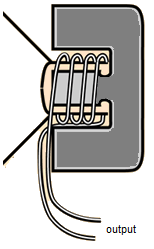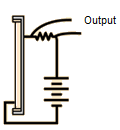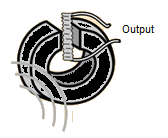In Part 1 and Part 2 of this series, we covered the physical properties of sound and acoustic waves. In this tutorial, we learned about the importance of converting sound into electrical signals.
Since sound waves are present in the form of vibration, they must first be converted electrically to be processed by electronic circuits. As mechanical energy, sound must be accurately represented as an electrical (analog) waveform for any successful signal processing operation.
In the air, the device used to convert sound waves into electrical (audio) signals is probably familiar to you – it's called a microphone.
The term “microphone” was first coined in 1875. It is a combination of “microscope,” in reference to the magnification of an item, and “telephone,” in reference to sound transmission. A microphone is a device that converts speech or sound into electrical signals. It is used for a variety of purposes, including radio, television, recording, live music, VOIP, and others.
How am microphones work
A microphone is a type of transducer, which is a device that converts one form of energy into another. More specifically, it converts mechanical energy (waveforms) into electrical energy.

A typical microphone
Different microphones use different methods to convert energy, but they all use a diaphragm, which is a thin membrane that vibrates in the presence of sound waves. When the diaphragm vibrates, it typically affects another component – such as a coil in a dynamic microphone or a plate in a condenser microphone.
The coil, for example, is also connected to a magnet, which produces a magnetic field. Whenever the coil of a dynamic microphone moves in the magnetic field, it creates an electrical current. This electrical signal is produced from the microphone, which is passed on to the amplifier (or pre-amplifier).
Because microphones use an inductor (like the coil) or some type of capacitor, they are not purely resistive. Therefore, it is important to note that the resistance of an inductor and a capacitor varies depending on the frequency of the sound – and different microphones will demonstrate different impedances based on the frequency range.
Furthermore, the frequency response of a microphone depends on the microphone's conversion technology.
Now, let's review how different types of microphones work.
Microphone classification
Microphones are typically categorized based on two features: the conversion technology used and its application.
Types of conversion technology include:
1. Dynamic
2. Condenser
3. Ribbon
4. Crystal
Dynamic microphones – A simple microphone that uses a coil and magnet to convert sounds into electrical signals, based on the principle of electromagnetic induction. A coil is attached to the diaphragm, which is surrounded by a permanent magnet. When the diaphragm vibrates, the attached coil also vibrates. An electrical signal proportional to the vibration is then generated.
- Pros: Economical to design and durable
- Cons: Unreliable frequency response (at least compared to a condenser or ribbon microphone)
The Inner Workings of a Dynamic Microphone

Condenser microphone – This type of microphone uses two plates – one is stationary and the other functions as a diaphragm. Any sound pressure changes the spacing between the two plates, which also changes the capacitance between them.
These plates are powered by a load, represented by the following equation:
Q = CV
Where…
C = capacitance
V = voltage
Q = Load between the plates
Whenever the space between the plates changes, the charge Q is stored between them and this causes a current in a resistance that is connected in series with the capacitor.
- Pros: Responds well to a dynamic range of frequencies
- Cons : Expensive and requires a power supply to charge the cards
The Inner Workings of a Condenser Microphone

Ribbon microphone – These microphones have a metallic ribbon, suspended between a permanent magnet. Whenever sound waves hit the tape, it vibrates. As the tape is in a magnetic field, any vibration induces a voltage.
The voltage produced is proportional to the speed of the tape. Voltage is also the audio signal received from the microphone.
- Pros: Adds boost to any bass
- Cons: Susceptible to external noise such as breeze or wind
The Inner Workings of a Ribbon Microphone
 Crystal Microphone – This microphone uses piezoelectric material to generate voltage. The material is attached to a diaphragm. When the diaphragm moves, it deforms the material, generating tension.
Crystal Microphone – This microphone uses piezoelectric material to generate voltage. The material is attached to a diaphragm. When the diaphragm moves, it deforms the material, generating tension.
The amount of deformation is proportional to the voltage generated, which is received by the microphone (as an audio signal). whenever stress is removed from the material, the stress dissipates.
- Pros: Produces a large electrical current for quality sound
- Cons: Suboptimal frequency response (even compared to a dynamic microphone)
The Inner Workings of a Crystal Microphone

Microphone Applications
Microphones have different directional properties, frequency responses, and impedances. These devices can capture sounds from one direction or multiple directions (omnidirectional), depending on their features and application.
The way a microphone “picks up” sounds is called a pattern. In terms of this standard, microphones can be categorized as follows…
1. Omnidirectional – can capture sound from all directions
2. Bidirectional – can pick up sound from the front and back of the microphone, but not from the sides
3. Unidirectional – can only capture sound from one direction, which is in front of the microphone

Microphones also display one of three distinct polar patterns. A polar pattern is a visual graph that indicates the sensitivity of a diaphragm at different angles.
By combining the directional property and the polar pattern, the “pickup” pattern of a microphone is determined. Pickup pattern refers to the sensitivity of the diaphragm and demonstrates how well a microphone captures sounds from different directions and angles.
In terms of their pickup pattern, microphones can be categorized as follows…

The figure eight microphone.
1. Omnidirectional – sensitive to all directions at all angles, equally.
2. Bidirectional or figure eight – sensitive to two opposite directions, which are the front and back or left and right sides of the microphone. This sensitivity is the same at all angles.
3 . Cardioid – extremely sensitive at the front of the microphone, with decreasing sensitivity at the sides and very little at the back. They provide isolation from unwanted environmental noise and are ideal for loud sounds.

Symbol representing cardioid microphones, as well as hyper, sub, and supercardioid microphones.
4. Hypercardioid or mini shotgun – sensitive in the front and back, but with a narrow range of angles in the front.
5. Half or subcardioid – sensitive in the front with less sensitivity in all other directions – which is a mix of a cardioid and omnidirectional microphone. They are ideal for use when the audio source is moving and never stationary.
6. Supercardioid or shotgun – narrow sensitivity angles at the front and even more so at the back. These microphones are good at picking up accurate sounds.
7. Lobar or unidirectional – strong, directional microphones with narrow pickup patterns. They are quite specific and are mainly used for video production.

Symbol of a unidirectional microphone.
Line Levels
The output level of a microphone is an extremely weak signal (only -60 dBm). However, the output strength can be increased using a preamplifier (also known as a preamplifier), which adjusts the input signal to line level.
Line level is the standard strength of an audio signal required to transmit the signal between audio sources to amplifiers, radios, TV, DVD players, etc. Typical line level voltage is 0.316 to 1.228 V.
Therefore, a preamplifier circuit is required in a microphone circuit to convert its level to line level.
In the next tutorial, we'll discuss another important part of an audio system: the speakers.
